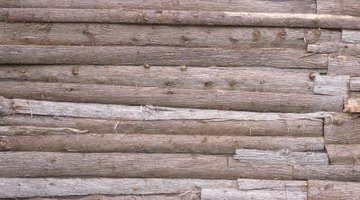Should I Use Screws or Nails With Cedar?
As a wood for building, cedar -- particularly western red cedar or eastern red cedar -- has few equals. The heartwood is knot-free and the grain of either variety is very straight and resists warping. Whether erecting a fence, siding a house or making furniture, cedar is an excellent choice. When choosing fasteners, what you are building may determine whether using nails or screws is the better option.
Fences

Western red cedar has long been used to build fences because it is resistant to rot and insect damage, particularly with higher grades of cedar. When attaching the rails and planks, either nails or screws could be used. The advantage of screws is they can be easily removed and reused if any part of the fence is damaged and requires replacement. If you select screws, drill pilot holes if necessary to prevent splitting the wood, but be careful not to make the holes too large; cedar is very soft, and oversize pilot holes can significantly diminish the fasteners' holding power.
Shingles and Clapboards
Because of its rot resistance and ability to accept both paints and stains, cedar is used for making both shingles and clapboards. Given the sheer number of fasteners shingling or clapboarding a structure will likely require, attaching them with nails is probably your best option. As you drive the nails, drive them just flush with the wood’s surface. Overdriving may crack the wood and ruin the piece you are using.
Furniture
Cedar is often used to build outdoor furniture. If you are building a bench, you might employ screws, nails or even bolts. Finish nails could be used to fasten the seat and back slats, and screws might be best for attaching the armrests and legs. For strong joints on table legs and other structural connections, rust-resistant machine bolts or carriage bolts may be appropriate. Set all nails slightly below the slat surfaces to avoid snagging someone or something. When attaching the arms and legs, consider drilling screw pockets into the wood and drive the screws in at their base. Then conceal the screw pockets with cedar plugs.
Preventing Stains
The chemical composition of cedar reacts with galvanized screws and nails, creating dark streaks that "bleed" from the fastener head onto the wood surface. The streaking can be noticeable on both stained and painted projects. So if appearance counts, your best bet is stainless steel fasteners. Some coated fasteners are designed to prevent staining on cedar, but if the fastener is stressed or otherwise damaged during installation or use, the coating may be breached, exposing the rust-prone metal of the fastener. This is not a concern with stainless steel. Stainless screws and nails are commonly sold in two grades: Type 304 and Type 316. The latter has more nickel and is recommended for areas near saltwater.
References
Writer Bio
Rich Finzer earned his boating license in 1960 and started his writing career in 1969. His writing has appeared in "Northern Breezes," "Southwinds," "Living Aboard," "Good Old Boat," "Latitudes & Attitudes," "Small Craft Advisor," "Life in the Finger Lakes," "BackHome" and "Dollar Stretcher" magazines. His maple syrup has won awards in competition. Rich has a Bachelor of Science in communications from Ithaca College.
Photo Credits
- Hemera Technologies/AbleStock.com/Getty Images
More Articles



